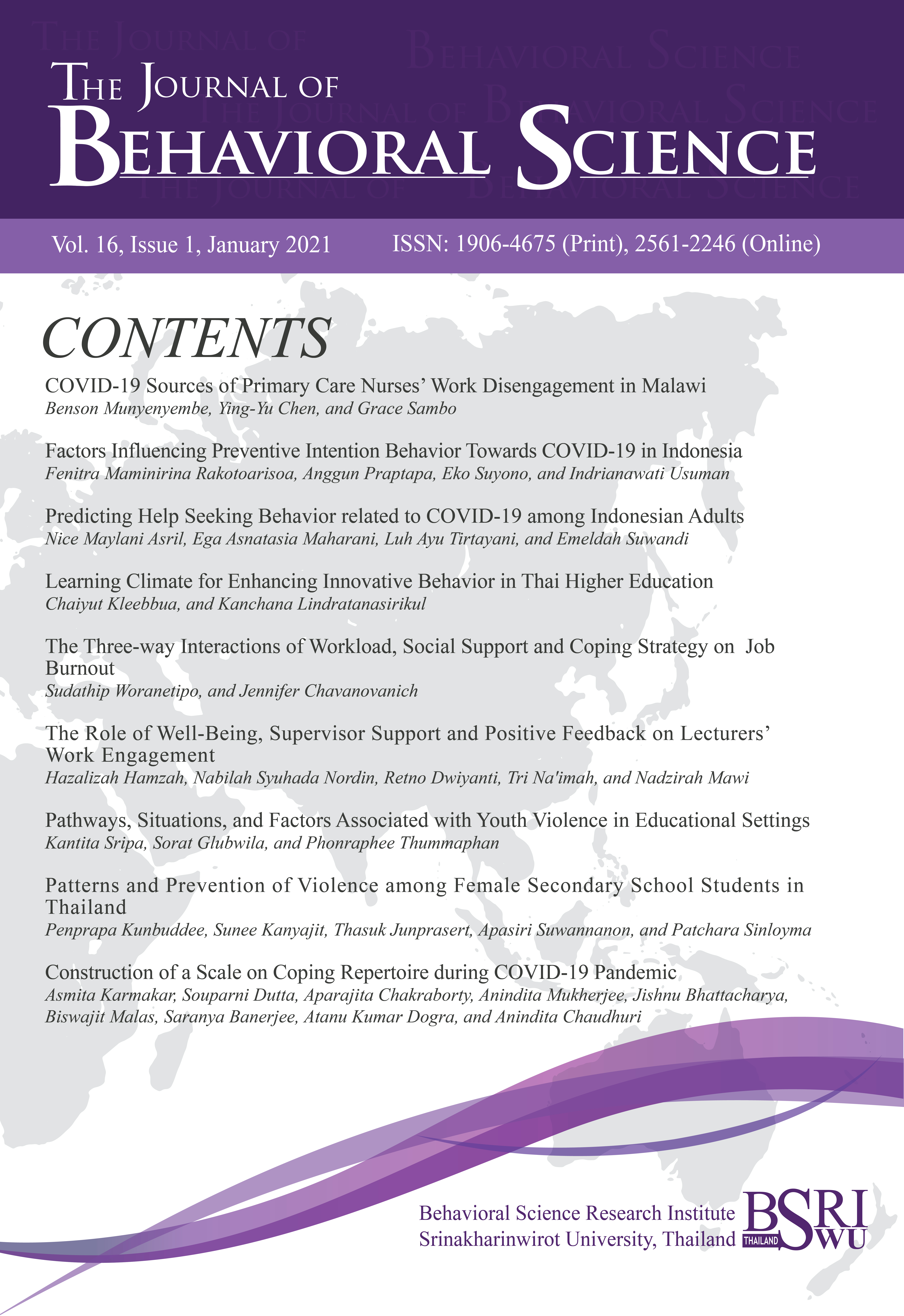Patterns and Prevention of Violence among Female Secondary School Students in Thailand
Main Article Content
Abstract
This qualitative research studied the patterns, causes, and conditions of the violence witnessed among female secondary school students in Bangkok, Thailand. Further to this, guidelines have been produced to prevent/solve violence among this demographic. Data was collected through in-depth interviews conducted with: (1) 21 female secondary school students, 1-3 of whom had been involved in violence; (2) 10 teachers with at least 5 years of experience in teaching and solving violence in the female secondary school context; and (3) 8 policymaking experts involved in preventing violence among female secondary school students. The results of the study illustrate that violence among female secondary school students in Bangkok manifests in patterns wherein: 1) the consequences result in physical damage, injury, and mental pain and negative feelings; and 2) victims experience violence directly through social media and the destruction of their personal belongings. In response to such occurrences of violence, policymaking institutions, schools, and teachers must give efforts towards implementing operations designed to reduce and eliminate violent incidences by emphasizing: (1) the development of thinking processes, behavioral control, and emotional regulation among children and young people; (2) the reinforcement of appropriate bystander behavior and environmental contexts which encourage children and young people to physically and mentally grow and thereby assume resilience; and (3) the creation of a non-violent community while monitoring and helping children and young people to have a safe and happy family life as well as the ability to suitably adapt in social context and environment.
Downloads
Article Details
References
American Academy of Pediatrics. (n.d.). Type of violence. American Academy of Pediatrics. https://www.aap.org/en-us/advocacy-and-policy/aap-health-initiatives/resilience/ Pages/Types-of-Violence-and-Prevalence.aspx
Aksan, N., Kısac, B., Aydın, M., & Demirbuken, S. (2009). Symbolic interaction theory. Procedia -Social and Behavioral Sciences, 1(1), 902-904. https://doi.org/10.1016/j.sbspro.2009.01 .160
Basile, K., C., Clayton, H. B., DeGue, S., Gilford, J. W., Vagi, K. J., Suarez, N. A., & Lowry, R. (2020). Interpersonal violence victimization among high school students—youth risk behavior survey, United States, 2019. MMWR supplements, 69(1), 28. http://dx.doi.org/10. 15585/mmwr.su6901a4
Bandura, A. (1986). Social Foundations of Thought and Action: A Social Cognitive Theory. Prentice–Hall.
Bosiakoh, T., & Andoh, P. (2010). Differential association theory and juvenile delinquency in Ghana’s capital city - Accra: the case of Ghana borstal institute. International Journal of Sociology and Anthropology, 2(9), 198-205. https://www.researchgate.net/publication/210382244_Differential_Association_Theory_and_Juvenile_Delinquency_in_Ghana%27s_Capital_City_-_Accra_The_Case_of_Ghana_Borstal_Institute
Cohen, R. S., & Wartofsky, M. W. (Eds.). (2013). Epistemology, Methodology, and the Social Sciences. Springer.
Esiri, M. (2016). The influence of peer pressure on criminal behavior. IOSR Journal of Humanities and Social Science, 21(1), 8-13.
Fakthongphan, P. (2010). Botkhwām wičhai rư̄ang ʻēkkalak læ khwām phūmčhai nai kān pen nakrīan rāchinī [Research paper on identity and pride of Rajini student]. http://www.rajini.ac.th/vijai/54/thesis.pdf
Fink, E. L. (2015). Symbolic Interactionism. In C. R. Berger, M. E. Roloff, S. R. Wilson, J. P. Dillard, J. Caughlin, & D. Solomon (Eds), The International Encyclopedia of Interpersonal Communication. John Wiley & Sons, Inc. https://doi.org/10.1002/9781118540190.wbeic266
Han, L., You, D., Gao, X., Duan, S., Hu, G., Wang, H., Liu, S., & Zeng, F. (2019). Unintentional injuries and violence among adolescents aged 12-15 years in 68 low-income and middle-income countries: A secondary analysis of data from the Global School-Based Student Health Survey. The Lancet. Child & Adolescent Health, 3(9), 616–626. https://doi.org/10.1016/
S2352-4642(19)30195-6
Hillis, S., Mercy, J., Amobi, A., & Kress, H. (2016). Global Prevalence of Past-year Violence Against Children: A Systematic Review and Minimum Estimates. Pediatrics, 137(3), e20154079. https://doi.org/10.1542/ peds.2015-4079
Jirasatitporn, J. (2017). Phatthanākān thāngkān sưksā khō̜ng phūying Thai Phō̜.Sō̜. sō̜ngphanhārō̜i sō̜ngphanhārō̜isīsip: laksūt kānsưksā kap kānphatthanā phūying sū khwām thansamai [The developemnt of female education between 1957 and 1997: Education curricula and the development of woman towards modernity] (Master thesis, Thammasat University). http://ethesisarchive.library.tu.ac.th/thesis/2017/TU_2017_5706030052_7391_8786.pdf
Johnson, A. (2014). Behaviorism, operant conditioning and B.F. Skinner. https://www.academia.edu/12527537/BEHAVIORISM_OPERANT_CONDITIONING_AND_B.F._SKINNER
Khantee, P. (2010). Tritdīʻātchavitthaya: Lakkān ngānwičhai lænayōbāiprayuk [Criminology Theory: Principles, Researches and Applied Policies]. Sunetflim Part., Ltd.
Know Violence in Childhood. (n.d.). Violence in childhood. Know Violence in Childhood. http://www.knowviolenceinchildhood.org/about/initiative
Letendre, J., & Smith, E. (2011). ‘It’s murder out today’: Middle school girls speak out about girl fighting. Children & Schools, 33(1), 47–57. https://doi.org/10.1093/cs/33.1.47
Mead, G. H. (1934). Mind, Self, and Society: From the Standpoint of a Social Behaviorist. University of Chicago Press.
Mehdinezhad, V. (2018). Causes of violence by high school students: A teachers and principal perspective. AJESI -Anadolu Journal of Educational Sciences International, 8(2), 124-148. https://www.researchgate.net/ publication/327403635_Causes_of_Violence_by_High_School_Students_A_Teachers_and_Principals_Perspective
Office of the United Nations Special Representative of the Secretary-General on Violence against Children. (2012). Tackling violence in schools: A global perspective. https://violenceagainst
children.un.org/sites/violenceagainstchildren.un.org/files/documents/publications/10._tackling_violence_in_schools_a_global_perspective.pdf
Seifert, K. (2014). Aversive Childhood Experiences, Without Appropriate Interventions, Lead to Life Course Violent and Criminal Behavior. Journal of Psychology & Clinical Psychiatry, 1(4), 00020. https://10.15406/jpcpy.2014.01.00020
Sianglaem, A., Nintachan, P., & Piasue, N. (2011). Kān sangkhro̜ ngānwičhai kīeokap patčhai thī kīeokhō̜ng kap kān kœ̄t panhā runrǣng nai khrō̜pkhrūa tō̜ sattrī nai sangkhom Thai [A research on factors related to the occurrence of domestic violence among women in Thai society]. The Journal of Psychiatric Nursing and Mental Health, 25(3), 38-55.
Skinner, B. F. (1948). ‘Superstition’ in the pigeon. Journal of Experimental Psychology, 38, 168-172. https://doi.org/10.1037/h0055873
Smith, P. (2010). Bullying in primary and secondary schools: Psychological and organizational comparisons. In S. Jimerson, S. Swearer & D. Espelage (Eds.). The International Handbook of School Bullying (pp. 137-149). Routledge.
Subrahmanian, R. (2017). Ending violence in childhood: Global report 2017. https://resourcecentre.savethechildren.net/node/12380/pdf/global_report_2017_ending_violence_in_childhood_overview.pdf
Sutherland, E. H. (1947). Principles of criminology (4th ed.). J. B. Lippincott.
Suthisorn, S. (2004). Ātchavitthaya [Criminology] (2nd ed.). Thammasat University Press.
Tarde, G. (1903). The Laws of Imitation. Patterson Press.
Tentschert, U. T. (2017). The relation between violence experienced in childhood and women’s exposure to violence in later life: Evidence from Europe. Journal of Interpersonal Violence, 32(12), 1874-1894. https://doi/pdf/10.1177/0886260517698952.
Thai Health Report. (2012). Dek nakrīan Thai kap phai khwāmrunrǣng nai rūa rōngrīan [Thai students and violence in schools]. Thai Health Report. https://www.thaihealthreport.com/
event2550-007
World Health Organization. (2002). World report on violence and health summary. https://www.who.int/violence_injury_prevention/violence/world_report/en/summary_en.pdf


